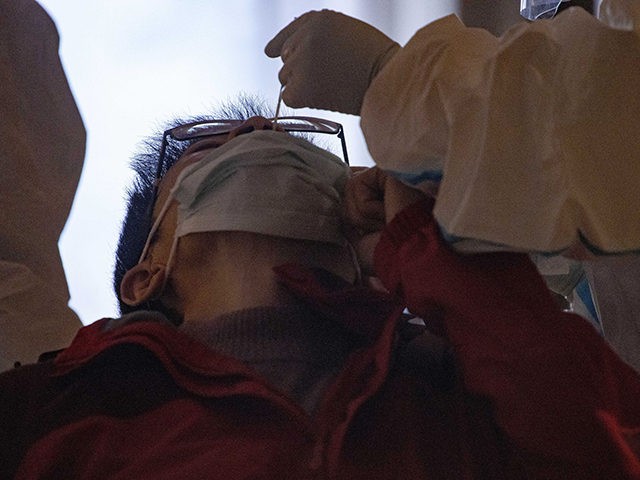Chinese National Health Commission official Liu Dengfeng admitted on Friday that his government did indeed destroy early samples of the Wuhan coronavirus, as has long been alleged by skeptics.
Liu claimed this was done to “prevent the risk to laboratory biological safety and prevent secondary disasters caused by unidentified pathogens.”
The South China Morning Post (SCMP) noted that critics such as U.S. Secretary of State Mike Pompeo have criticized the Chinese Communist Party (CCP) for refusing to provide samples to the international medical community when the Wuhan outbreak began in late 2019 and for destroying those samples. Liu insisted there was nothing nefarious about the destruction:
“The remarks made by some US officials were taken out of context and intended to confuse,” [Liu] said at a briefing in Beijing.
When the pneumonia-like illness was first reported in Wuhan, “national-level professional institutes” were working to identify the pathogen that was causing it, Liu said.
“Based on comprehensive research and expert opinion, we decided to temporarily manage the pathogen causing the pneumonia as Class II – highly pathogenic – and imposed biosafety requirements on sample collection, transport and experimental activities, as well as destroying the samples,” he said.
Liu added that this was in line with China’s standard practice for handling highly pathogenic samples, which should not be done by labs that do not meet the requirements.
The SCMP quickly pointed out that Liu’s statements were not accurate since it has been established by earlier reports that major Chinese virus labs were ordered to destroy their samples after correctly identifying the mysterious new disease that emerged in December as a member of the SARS family.
As the New York Post summarized in February:
In late December, several genomics companies tested samples from sick patients in Wuhan — the center of the coronavirus outbreak — and noticed alarming similarities between their illnesses and the 2002 SARS virus, the Sunday Times of London reported, citing Chinese business news site Caixin Global.
The researchers alerted Beijing of their findings — and on Jan. 3, received a gag order from China’s National Health Commission, with instructions to destroy the samples.
Rather than hunkering down to contain the virus, Wuhan officials went ahead with their annual potluck dinner for 40,000 families.
The alleged cover-up continued when representatives from the US Centers for Disease Control and Prevention on Jan. 8 visited Wuhan, where officials intentionally withheld information that hospital workers had been infected by patients — a telltale sign of contagion.
News of the virus’ highly contagious nature didn’t surface publicly until Jan. 20. Wuhan was locked down and a mass quarantine ordered three days later.
In early May, a leaked Western intelligence document described Chinese laboratories deliberately destroying evidence that the coronavirus could be transmitted between humans, including virus samples, during the early weeks of the outbreak when the CCP was eager to conceal that dangerous information. The document described China’s actions as an “insult to international transparency.”
The U.S. Department of Homeland Security (DHS) reportedly produced an analysis at roughly the same time that said China wanted to keep the rest of the world from knowing how contagious the coronavirus was because Chinese companies were frantically buying up medical supplies and protective gear from other countries, and would have encountered difficulty making those bulk purchases if the other countries understood how rapidly the virus could spread.
The SCMP reported that Chinese National Health Commission officials on Friday also denied multiple statements by World Health Organization (W.H.O.) officials that they have been refused access to Wuhan and its virology institute, the lab frequently discussed as a possible source of the outbreak.
“The W.H.O. has never made a request to visit a certain laboratory, so the statement that the WHO was denied a visit to the Wuhan laboratory is untrue,” said senior Chinese official Li Mingzhu.
The Wall Street Journal (WSJ) reported on Tuesday that the CCP is still stalling investigations into Wuhan, its notorious virus-spreading “wet markets,” and the Wuhan Institute of Virology. Eyewitnesses in China confirmed they gathered data and physical evidence from Wuhan in December that is still hidden from the world by the Chinese government, despite its constant claims of transparency and cooperation.
The Chinese National Health Commission pointedly refused to answer the WSJ’s questions about this evidence, responding with CCP political boilerplate about how “the virus should not be linked to any particular country, region, or people” and all nations should “join forces and work together, rather than blaming each other and shirking responsibility.”
The WSJ also noted that despite China’s denials that it has stymied W.H.O. investigations, W.H.O. officials confirmed that investigative data long promised by China still has not been delivered to the organization, and China is indeed still thwarting efforts by international investigators to visit the outbreak area in Wuhan.

COMMENTS
Please let us know if you're having issues with commenting.